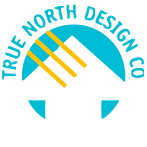Why we design green
At True North Design Co, we’re proud to be GreenSmart accredited professionals.
We believe that green design is clever design – saving you money, making your home more comfortable, increasing your home’s energy efficiency, all while protecting our environment.
Save Money
Clever and Comfortable
Beautiful Gardens
A Smarter Building Process
Compare the features of a GreenSmart home
Water in a GreenSmart Home
- GreenSmart homes are fitted with AAA-Rated water-efficient showerheads and taps. AAA-Rated showerheads save up to:
- $1,000 over 10 years in water and electricity costs
- 250,000 litres of water, and;
- 10 tonnes of greenhouse emissions
- The AAA-Rated Dual Flush toilet in GreenSmart homes uses just 3 litres for a half flush
- A water-efficient landscape design that includes native and low-water-use plants and lawns to ensure outdoor watering requirements are minimised
- Through the use of rain water tanks, and by improving the soil’s ability to hold water, stormwater run-off can be retained on site for later use.
Water in a Conventional Home
- A standard showerhead uses more than twice as much water as a AAA-Rated showerhead, costing more in water bills and also energy to heat hot water
- A single flush toilet uses 12 litres for a flush, compared to only 3 litres in a GreenSmart home
- Gardens use an enormous 25% of all water consumed by the average Sydney home
- High levels of stormwater run-off leads to localised flooding and silting in local creeks and rivers.
Energy in a GreenSmart Home
- Each GreenSmart home is 5-star energy efficiency rated by NatHERS. This is the highest possible rating and requires that homes use the best orientation, insulation, thermal mass, ventilation and shading for maximum comfort and energy efficiency. Because of these requirements, a 5-star rated home can save you hundreds of dollars a year on energy bills.
- The GreenSmart homes are fitted either with a AAA-Rated Gas hot water system or a solar hot water system. A gas system can save you up to $650 over 10 years, and save greenhouse gas emissions of around 6.5 tonnes.
- A solar hot water system will save up to $2,500 and 25 tonnes of greenhouse gas emissions in 10 years.
- EnergySmart compact fluorescent light bulbs are used throughout GreenSmart homes and should save around $50 in energy bills for each bulb, and around half a tonne of greenhouse gas emissions a year.
- GreenSmart homes use energy-smart, top-rated white goods. Each top star-rated appliance can save hundreds of dollars in energy bills.
Energy in a Conventional Home
- Many now require a minimum of 3.5 stars NatHERS rating before they grant development approval. The higher the NatHERS rating, the lower the energy bill and the more comfortable the home should be.
- A conventional electric hot water system is responsible for up to half the household energy bill per year.
- Most homes use standard incandescent bulbs, which have a much shorter lifespan and are much more energy hungry.
- Whitegoods with lower energy star ratings use more electricity and are responsible for more greenhouse gas emissions. They also cost more to run.
Waste in a GreenSmart Home
- More than half of the building waste from a GreenSmart homes will be recycled
- Recycled materials used in landscaping and construction
- Native species are also used in landscaping – reducing green waste, saving water and reducing the maintenance and upkeep required
- Mulches and soil conditioners with a recycled component, are used in the garden, which saves resources and water
- Compost and worm farms are used for food and garden waste – creating fantastic soil conditioners and fertilisers out of household waste.
Waste in Conventional Homes
- 100% of construction waste is generally sent to land-fill (construction & demolition waste composes 25% of total land-fill waste in Australia)
- Conventional homes typically use few recycled materials
- Gardens without mulches have a much higher demand for water
- Manufactured fertilisers and soil conditioners are expensive and can negatively impact stormwater quality.
“As the whole house faces true(ish) north, all rooms are bathed in natural light. We also appreciate the little nooks and crannies of the house – there are various small verandah spaces that protect us from strong heat and we can sit undercover, with great satisfaction, as it rains. All of the intelligent passive and active solar design features make a difference to our lived experience of the house.
Thank you, Tony and Lucy, for co-creating this amazing home design and build process. Your expertise, humour, candor (read: reassurance that all would be well!) is much appreciated, especially now, as we sink into the reality that this home is actually ours for the experiencing and growing into.”
– KERRY & HENDRE
The GreenSmart Checklist
Some important points to consider when building your GreenSmart home:
- Choose a house plan that locates living areas on the north side of your block – (match the house to the block).
- If your block faces north, consider using courtyard walls to provide outdoor space accessible from the living areas.
- Maximise living areas that are oriented between 20 degrees west of north and 30 degrees east of north.
- Imagine a line projected up at an angle of 30 degrees from the living area windows to the north and make sure that anything that throws shade falls under this line.
- In a house with northern glass, concrete slabs and internal brick walls can provide thermal mass to help keep you cool in summer, warm in winter.
- Ask for R2 Insulation batts in walls and R4 in ceilings.
- Insulate under timber floors and along the edge of concrete slabs (slabs loose heat to moist soil at the edge of the building).
- Ask your builder to include foil sarking under the roof and sizalation in walls.
- Consider double glazing for the Southern Highlands climate.
- Plan for cross ventilation, by sliding opening windows and doors on the opposite sides of the narrow axis of the house.
- Plant deciduous trees to the north and evergreen trees to the east and west.
- Wherever possible, use compact fluorescent light bulbs or other energy efficient lighting within the house.
- Check the energy rating of the appliances you are using and choose those with the highest rating.
- Consider investing in a solar hot water system.
- Ask your designer about “FirstRate”, an energy-rating software tool that helps you assess construction options.
- Use water saving taps, shower heads, toilets and other flow regulating devices.
- Make provision for recycling to be part of your kitchen design.
- Design your garden to minimise water usage.


